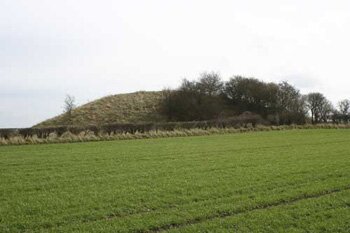One of our projects this week is the geophysical survey of burial mounds tentatively dated to the Iron Age. Diving Doc, Moneypenny and I will be using our new gear from Accurate Locators. More later.
Some background:
Tumulus
A tumulus (plural tumuli or tumuluses) is a mound of earth and stones raised over a grave or graves. Tumuli are also known as barrows, burial mounds or kurgans and can be found throughout much of the world. A tumulus composed largely or entirely of stones is usually referred to as a cairn.
The method of inhumation may involve a cist, a mortuary enclosure, a mortuary house or a chamber tomb. Examples of barrows include Duggleby Howe and Maeshowe.
 Duggleby Howe (also known as Howe Hill, Duggleby) is one of the largest round barrows in Britain, located on the southern side of the Great Wold Valley in East Yorkshire, and is one of four such monuments in this area, known collectively as the Great barrows of East Yorkshire. Duggleby Howe is believed on the basis of artefacts recovered to be of Late Neolithic date, but no radiocarbon dates are available.
Britain
Duggleby Howe (also known as Howe Hill, Duggleby) is one of the largest round barrows in Britain, located on the southern side of the Great Wold Valley in East Yorkshire, and is one of four such monuments in this area, known collectively as the Great barrows of East Yorkshire. Duggleby Howe is believed on the basis of artefacts recovered to be of Late Neolithic date, but no radiocarbon dates are available.
Britain
In Britain, early references to tumuli were made by William Camden, John Aubrey, and William Stukeley. During the 19th century in England the excavation of tumuli was a popular pastime amongst the educated and wealthy middle classes who became known as "barrow-diggers".
This leisure activity played a key role in laying the foundations for the scientific study of the past in Britain. Barrows were popularly used to bury the dead from the late Neolithic until the end of the Bronze Age 2900-800BCE.
Square barrows were occasionally used in the Iron Age 800BCE -43CE in the east of England. The traditional round barrow experienced a brief resurgence after the Anglo-Saxon invasion as Scandinavian burial practice became popular CE500-600.
These later barrows were often built near older Bronze Age barrows.
Types of barrows
Archaeologists often classify tumuli according to their location, form, and date of construction. Some British types are listed below:
* Bank barrow
* Bell barrow
* Bowl barrow
* D-shaped barrow A round barrow with a purposely flat edge at one side often defined by stone slabs
* Fancy barrow A generic term for any Bronze Age barrows more elaborate than a simple hemispherical shape.
* Long barrow
* Oval barrow A type of Neolithic long barrow consisting of an elliptical, rather than rectangular or trapezoidal mound.
* Platform barrow The least common of the recognised types of round barrow, consisting of a flat, wide circular mound, which may be surrounded by a ditch. They occur widely across southern England with a marked concentration in East and West Sussex.
* Pond barrow a barrow consisting of a shallow circular depression, surrounded by a bank running around the rim of the depression. Bronze age
* Ring barrow a bank which encircles a number of burials.
* Round barrow a circular feature created by the Bronze Age peoples of Britain and also the later Romans, Vikings and Saxons. Divided into sub classes such as saucer and bell barrow. The Six Hills are a rare Roman example.
* Saucer barrow circular Bronze Age barrow featuring a low, wide mound surrounded by a ditch which may be accompanied by an external bank.
* Square barrow A burial site, usually of Iron Age date, consisting of a small, square, ditched enclosure surrounding a central burial, which may also have been covered by a mound
References
* Albright, William F. (1923). "Interesting finds in tumuli near Jerusalem". Bulletin of the American Schools of Oriental Research 10 (April): 1-3.
* Amiran, Ruth (1958). "The tumuli west of Jerusalem, Survey and Excavations, 1953". Israel Exploration Journal 8 (4): 205-27.
* Barkay, Gabriel (2003). "Mounds of mystery: where the kings of Judah were lamented". Biblical Archaeology Review 29 (3): 32-9, 66, 68.
* Grena, G.M. (2004). LMLK--A Mystery Belonging to the King vol. 1. Redondo Beach, California: 4000 Years of Writing History. ISBN 0-9748786-0-X.
* Grinsell, L.V., 1936, The Ancient Burial-mounds of England. London: Methuen.
* Nelson, Sarah Milledge, "The Archaeology of Korea"". New York: Cambridge University Press. id=ISBN 0-521-44043-6


